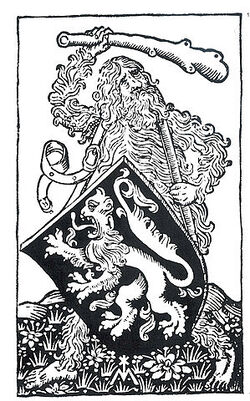Wild man (nonfiction): Difference between revisions
Jump to navigation
Jump to search
No edit summary |
No edit summary |
||
| Line 1: | Line 1: | ||
The '''wild man''' (also '''wildman''', or "wildman of the woods", | [[File:Wilder_Mann_mit_umgehängtem_Wappen_1487.jpg|250px|thumb|Wilder Mann mit umgehängtem Wappen (1487).]]The '''wild man''' (also '''wildman''', or "wildman of the woods", | ||
The wild man appears in the artwork and literature of medieval Europe. | The wild man appears in the artwork and literature of medieval Europe. | ||
| Line 9: | Line 7: | ||
The defining characteristic of the figure is its "wildness"; from the 12th century they were consistently depicted as being covered with hair. | The defining characteristic of the figure is its "wildness"; from the 12th century they were consistently depicted as being covered with hair. | ||
== | == In the News == | ||
<gallery mode="traditional"> | |||
</gallery> | |||
== Fiction cross-reference == | == Fiction cross-reference == | ||
| Line 15: | Line 16: | ||
* [[Salvatore]] | * [[Salvatore]] | ||
== External links | == Nonfiction cross-reference == | ||
External links: | |||
* [https://en.wikipedia.org/wiki/Wild_man Wild man] @ Wikipedia | * [https://en.wikipedia.org/wiki/Wild_man Wild man] @ Wikipedia | ||
Revision as of 18:06, 24 June 2016
The wild man (also wildman, or "wildman of the woods",
The wild man appears in the artwork and literature of medieval Europe.
He is comparable to the satyr or faun type in classical mythology, and to Silvanus, the Roman god of the woodlands.
The defining characteristic of the figure is its "wildness"; from the 12th century they were consistently depicted as being covered with hair.
In the News
Fiction cross-reference
Nonfiction cross-reference
External links:
- Wild man @ Wikipedia
